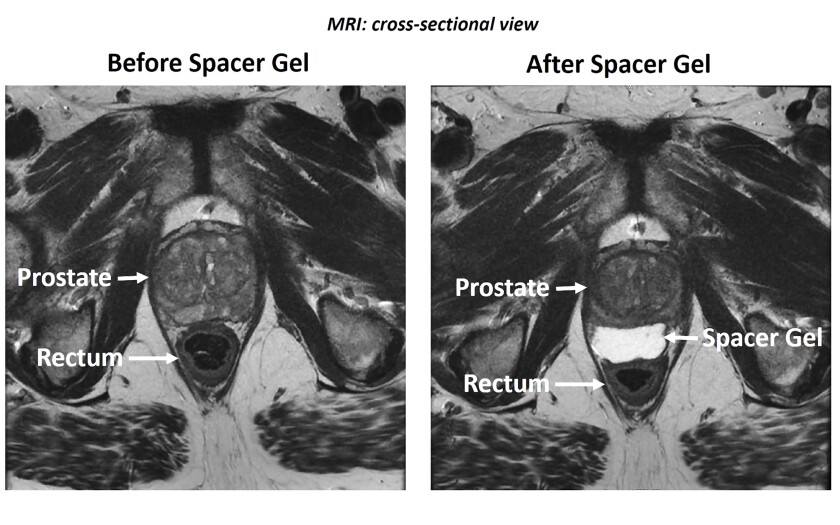The instrument Dr. Matthew Emme held in his hand was wire-thin like a needle, but long like a dagger.
Dick Blondo leaned far out of his chair, scrutinizing the needle — for that is what it was — with fascination.
He had encountered one like it before, but that was months earlier, and he had been under the blessed effects of anesthesia at the time.
“General anesthesia is a much more comfortable way to do it than me trying to do this in the office without it,” said Emme, a urologist at St. Luke’s. “Because it does involve putting needles in places that are sensitive and uncomfortable.”
It should be said here that this is not a story for the squeamish. If you are squeamish, perhaps we already lost you at “needle.”
ADVERTISEMENT

What Emme is slowly, steadily driving in through the needle for 13-15 seconds — sorry, warned you — is a substance with a name that sounds like it comes out of an old “Jetsons” TV cartoon: the SpaceOar Hydrogel.
This stuff, which is 90% water, consists of two liquid compounds traveling through the needle. But if Emme lets up, it will start to gel while still in the needle. That isn’t supposed to happen until it reaches its destination, which is the space between a man’s prostate and his rectum.
There, for the 90 days before it harmlessly disintegrates (it’s biodegradable), the hydrogel acts as a buffer, a demilitarized zone, if you will, protecting the rectum from the effects of radiation. Because the hydrogel is intended as a line of defense for a man who is being treated, as was Blondo, for prostate cancer.
“We want to get as much dose of radiation into the prostate and as little into the surrounding tissues (as we can),” said Dr. Steven Bonin, a radiation oncologist who with colleague Dr. Nils Arvold is responsible for bringing SpaceOar Hydrogel to St. Luke’s.
Bonin and Arvold said they were impressed by the results of a big study published in 2017. It found, Arvold summarized, that using the gel can reduce the number of rectal side effects caused by the radiation. Additional studies showed it also can reduce bladder and erectile side effects. Plus, having the gel in place also may allow for a greater radiation dose in certain circumstances. That may increase the ability to kill the cancer.
Bonin and Arvold only needed a urologist to come on board, and Emme was happy to do so.
ADVERTISEMENT

“It didn’t seem like there was actually much of a downside to doing it,” Emme said.
Every procedure entails a risk-benefit analysis, the urologist said. But in this case, the benefits far outweighed the minimal risks.
St. Luke’s first started offering the hydrogel on Feb. 15, the first hospital north of the Twin Cities to do so, as the St. Luke’s marketing people are happy to point out. Dick Blondo was one of the patients who had the gel injected that day.

Blondo, 73, has a Lincolnesque beard and, for that matter, a Lincolnesque face. After he served as an aircraft maintenance specialist in the Vietnam War, Blondo and his wife, Ann, made their careers and their home in South Dakota. But, longing for trees, they retired to Willow River, settling permanently about six years ago.
ADVERTISEMENT
During a routine physical last year at the Twin Ports VA Clinic in Superior, Blondo’s PSA was high, and his doctor felt a lump. He was referred to the Twin Cities, where he was diagnosed with prostate cancer, and radiation therapy was recommended.
Not relishing a daily drive to the Twin Cities, the Blondos asked if they could have the treatment done in Duluth, and the VA approved. After an online search, they decided they liked what they saw at St. Luke’s.
They didn’t know the gel was available until Emme explained it to them. Dick Blondo was an easy sell.
“The way he explained it, it protected something, and it was good,” Blondo recalled. “I do woodworking, and if you’re doing something with wood, you want to protect it. That’s how I picture it.”
The St. Luke’s marketing people should have had a camera running while Dick Blondo was talking, because they’ll never find a more enthusiastic advocate. Blondo raved about the way he was treated throughout his care, but particularly on the day of the procedure. He recalled telling the anesthesiologist — or “gas man,” as Blondo put it — that he hoped the whole thing would be done soon because he’d been denied his morning bowl of Cheerios.
“Pretty soon, he comes back and hands me one of them dishes of Cheerios,” Blondo continued. “He said, ‘This is for you, but not till it’s over.’”

ADVERTISEMENT
After a break of about 10 days, the daily radiation treatments began — five days a week for 28 days.
“We were kind of selfish,” Ann Blondo said cheerfully. “We were a little concerned with getting it all done before summer plans.”
Dick Blondo reported he has had no side effects of any sort. Even better, his last PSA count was “very low.”
The hydrogel is an extra in prostate cancer radiation treatment, and the doctors couldn’t say how much it costs. But it’s covered under most Medicare plans, Arvold said, and private insurers tend to follow along. They’ve yet to have an insurer deny pre-approval, he added.
In Blondo’s case, the VA covered everything, Dick Blondo said.







